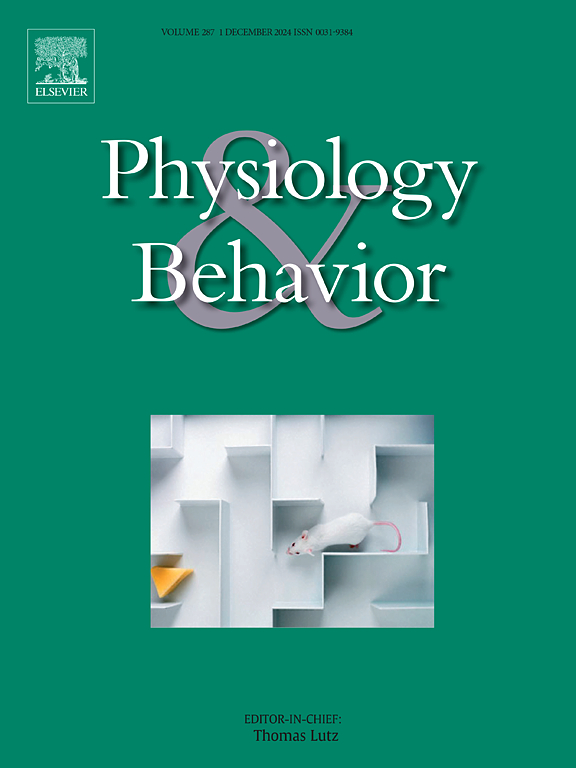Forced wheel running pre-conditioning diminishes reward learning induced by methamphetamine: Involvement of orexin 1 receptor in the hippocampus
IF 2.5
3区 医学
Q2 BEHAVIORAL SCIENCES
引用次数: 0
Abstract
Methamphetamine (METH) is a highly addictive drug that leads to neurobehavioral changes related to the brain's reward circuit. Orexin and orexinergic receptors, found in crucial brain areas involved in reward processing, may play a significant role in reward mechanisms and addiction. Studies have shown that physical exercise can be an effective non-pharmacological approach to controlling drug use but limited research explores its role as pre-conditioning to prevent dependency on narcotics. In this study, 48 male Wistar rats were assigned into six groups: exercise training+saline (EX-SA), exercise training+METH 1mg/kg (EX-METH1), exercise training + METH 2 mg/kg (EX-METH2), control+saline (CON), control+METH 1 mg/kg (CON-METH1), control+METH 2 mg/kg (CON-METH2). The pre-conditioning groups underwent forced wheel-running training (five days a week, at 65 % Vmax) for eight weeks. Following pre-conditioning with exercise training, the METH groups received intraperitoneal (IP) METH injections using the conditioned place preference (CPP) model. After the post-test, the animals were dissected, and hippocampal tissue was collected to measure orexin receptor1 (OXR1) expression levels. The results showed that long-term, moderate-intensity forced exercise pre-conditioning prevented METH-induced CPP. However, CPP was observed only in the EX-METH2 group, receiving a double dose of the drug. Molecular analysis also revealed a significant increase in OXR1 expression in the hippocampus following METH injections, while physical exercise caused suppression in OXR1 increment. Seemingly, prior exercise influences this pathway and effectively prevents conditioning to METH, probably through OXR1, indicating an adaptation in the mesolimbic reward pathway that helps protect against METH addiction.
强迫性车轮跑前调节减少甲基苯丙胺诱导的奖励学习:海马中Orexin 1受体的参与。
甲基苯丙胺(冰毒)是一种极易上瘾的药物,会导致与大脑奖赏回路相关的神经行为改变。食欲素和食欲能受体位于大脑中参与奖励处理的关键区域,可能在奖励机制和成瘾中发挥重要作用。研究表明,体育锻炼可以是一种有效的非药物方法来控制药物使用,但有限的研究探索其作为预防对麻醉品依赖的预处理作用。将48只雄性Wistar大鼠分为6组:运动训练+生理盐水(EX-SA)、运动训练+甲基1mg/kg (EX-METH1)、运动训练 + 甲基2mg/kg (EX-METH2)、对照组+生理盐水(CON)、对照组+甲基1mg/kg (CON- meth1)、对照组+甲基2mg/kg (CON- meth2)。预处理组进行了为期8周的强制轮跑训练(每周五天,65% Vmax)。在运动训练预处理后,冰毒组采用条件位置偏好(CPP)模型腹腔注射冰毒。后测后解剖动物,收集海马组织,测定食欲素受体1 (OXR1)表达水平。结果表明,长期、中等强度的强迫运动预处理可预防甲基苯丙胺诱导的CPP。然而,仅在接受双剂量药物的EX-METH2组观察到CPP。分子分析还显示,冰毒注射后海马中OXR1表达显著增加,而体育锻炼抑制了OXR1的增加。似乎,先前的锻炼影响了这一途径,并有效地阻止了对冰毒的调节,可能是通过OXR1,表明中边缘奖励途径的适应有助于防止冰毒成瘾。
本文章由计算机程序翻译,如有差异,请以英文原文为准。
求助全文
约1分钟内获得全文
求助全文
来源期刊

Physiology & Behavior
医学-行为科学
CiteScore
5.70
自引率
3.40%
发文量
274
审稿时长
47 days
期刊介绍:
Physiology & Behavior is aimed at the causal physiological mechanisms of behavior and its modulation by environmental factors. The journal invites original reports in the broad area of behavioral and cognitive neuroscience, in which at least one variable is physiological and the primary emphasis and theoretical context are behavioral. The range of subjects includes behavioral neuroendocrinology, psychoneuroimmunology, learning and memory, ingestion, social behavior, and studies related to the mechanisms of psychopathology. Contemporary reviews and theoretical articles are welcomed and the Editors invite such proposals from interested authors.
 求助内容:
求助内容: 应助结果提醒方式:
应助结果提醒方式:


